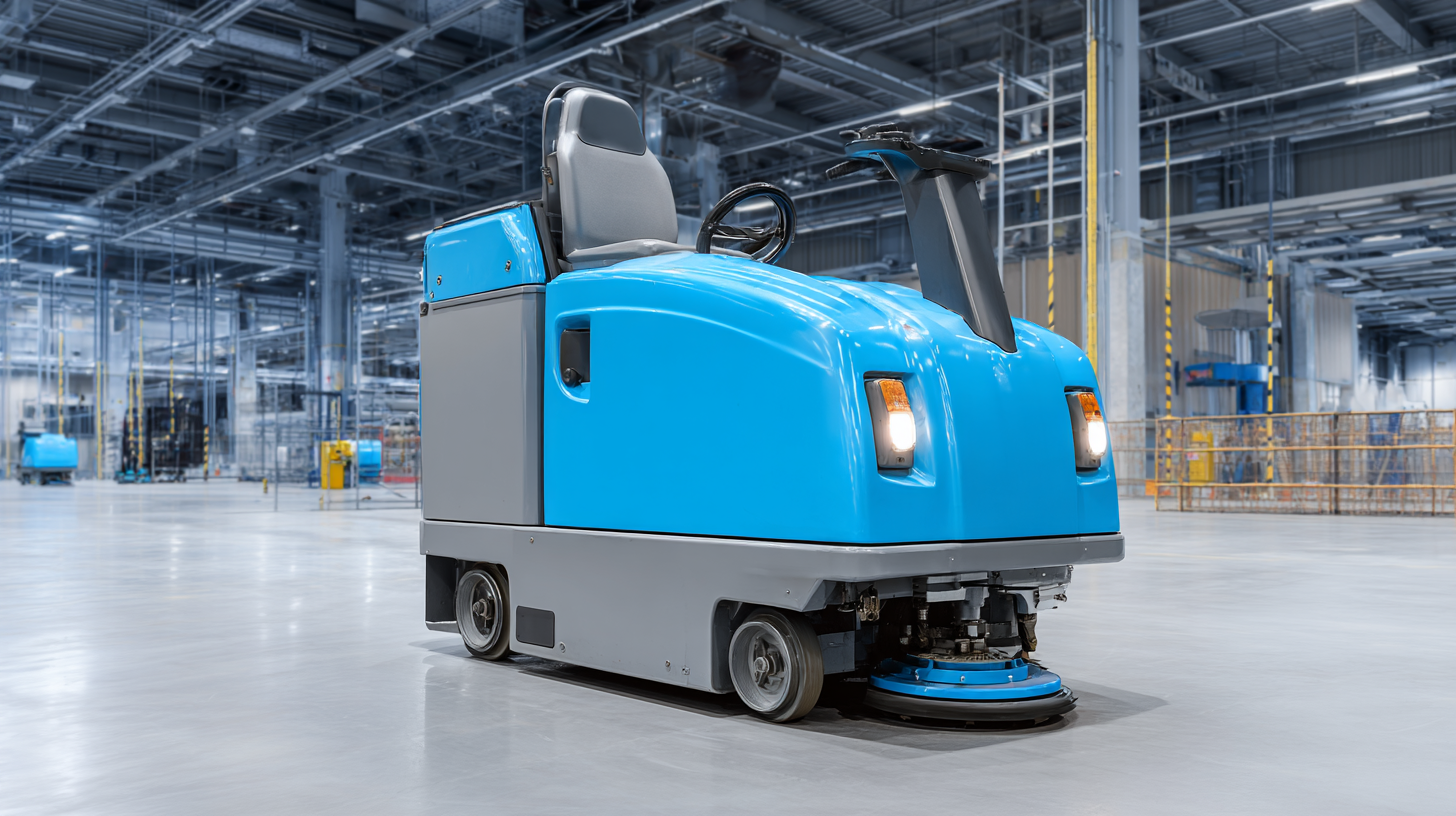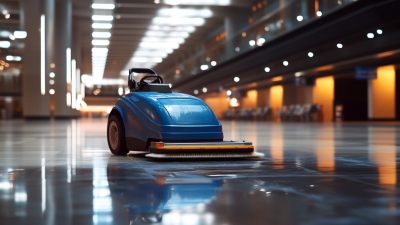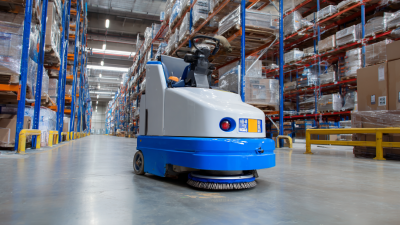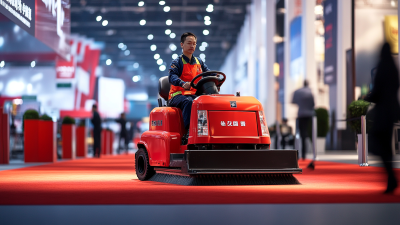Inquiry
Form loading...
In today's rapidly evolving industrial landscape, maintaining a clean and safe work environment is paramount to enhancing productivity and ensuring employee well-being. One essential tool in achieving this goal is the Industrial Floor Scrubber. According to a report by Grand View Research, the global commercial floor scrubbers market size is expected to reach USD 1.4 billion by 2025, driven by an increasing demand for sanitation in various sectors, including manufacturing, healthcare, and warehousing.

Industrial Floor Scrubbers are engineered to deliver superior cleaning results while reducing labor costs and improving workplace safety. By integrating advanced technologies, such as automation and real-time monitoring, these machines not only provide a thorough clean but also contribute to sustainability efforts through reduced water and chemical usage. This article will explore the future of clean workplaces with a focus on how Industrial Floor Scrubbers can revolutionize industrial cleaning practices, ensuring a safer and more efficient environment.
Maintaining a clean workspace is critical for ensuring employee health and safety. Research shows that well-maintained environments can significantly reduce absenteeism by up to 20%, as employees are less likely to fall ill when working in clean conditions. The rise of eco-friendly cleaning solutions, such as industrial floor scrubbers, has made it easier for businesses to uphold these cleanliness standards while also contributing to a healthier planet. Companies embracing these practices are not just complying with safety regulations; they are also enhancing employee morale and retention rates.
In the wake of the COVID-19 pandemic, 66% of employees expressed a desire for better office cleaning practices, indicating a shift in workplace priorities. New industry guidelines have emerged that emphasize the role of deep cleaning and hygiene protocols. Adherence to these standards has proven to improve overall employee satisfaction, with surveys showing that cleanliness directly affects workers' perceptions of safety in their offices. Integrating effective cleaning solutions not only addresses immediate safety concerns but also paves the way for a sustainable and productive work environment.
This bar chart illustrates the correlation between workspace cleanliness and employee health indicators. The data reflects findings from various studies on the importance of maintaining clean work environments.
Modern industrial floor scrubbers are revolutionizing the way workplaces maintain cleanliness, ensuring a safer environment for employees. One of the key features of these advanced scrubbers is their automated cleaning ability. Equipped with smart sensors, they can navigate complex workspaces, adapt to varying floor types, and efficiently clean large areas without the need for manual intervention. This not only saves time but also reduces the risk of accidents related to messy floors.

Another essential feature is their eco-friendly design. Many modern floor scrubbers utilize biodegradable cleaning solutions and advanced water conservation techniques, minimizing their environmental impact while still achieving superior cleaning results. Additionally, innovations like HEPA filtration systems help improve indoor air quality by trapping dust and allergens, contributing to a healthier workplace. These features combined highlight the importance of investing in modern industrial floor scrubbers, as they not only enhance cleanliness but also promote safety and sustainability in working environments.
Industrial floor scrubbers play a crucial role in enhancing workplace efficiency, particularly in environments where cleanliness is paramount for both safety and productivity. According to a report by the Cleaning Industry Research Institute, maintaining a clean facility can improve employee morale by up to 30%, which directly correlates with increased output. These machines not only reduce cleaning time significantly by automating scrubbing and drying processes but also ensure that the cleaning is consistent and thorough—two factors that manual cleaning often fails to achieve. For instance, a study from the International Sanitary Supply Association revealed that using industrial floor scrubbers can decrease labor costs by approximately 70% in comparison to traditional cleaning methods.

Tips: To maximize the benefits of industrial floor scrubbers, schedule regular maintenance to ensure the machines operate efficiently. Training staff on proper scrubber usage can also lead to better cleaning results and quicker turnaround times, further enhancing overall production dynamics. Additionally, selecting the right type of scrubber, whether walk-behind or ride-on, depends on the size of the area to be cleaned; for larger spaces, ride-on models can save even more time and effort.
With the implementation of industrial floor scrubbers, workplaces are not only becoming cleaner but also safer. A cleaner environment reduces risks associated with slips and falls, as dirty and wet floors can pose significant hazards. According to the Occupational Safety and Health Administration (OSHA), slips, trips, and falls account for over 25% of all workplace injuries. Investing in quality floor scrubbers can mitigate these risks, creating a safer atmosphere that encourages productivity and reduces downtime due to accidents.
The environmental benefits of using eco-friendly floor cleaning solutions are profound and multifaceted. By incorporating biodegradable detergents and sustainable cleaning technologies, businesses can significantly reduce their carbon footprint and minimize harmful chemical runoff. Traditional floor cleaning methods often involve potent chemicals that can contaminate waterways and adversely affect local ecosystems. In contrast, eco-friendly alternatives not only clean effectively but also ensure that the surrounding environment remains unpolluted.
Moreover, the utilization of industrial floor scrubbers designed with eco-conscious principles can bolster workplace safety. These machines often feature advanced filtration systems that capture dust and allergens, creating healthier indoor air quality for employees. By reducing reliance on harsh chemicals, companies can avoid potential health hazards associated with traditional cleaning agents, leading to fewer workplace accidents and health-related absences. In this way, embracing environmentally friendly cleaning solutions not only serves to protect the planet but also enhances the well-being of workers.
| Feature | Description | Environmental Benefit | Workplace Safety Impact |
|---|---|---|---|
| Reduced Water Usage | Utilizes advanced technology to clean with less water. | Conserves water resources and reduces wastewater generation. | Minimizes slippery floors due to excess water. |
| Eco-Friendly Cleaning Solutions | Employs biodegradable cleaners that are less harmful. | Reduces chemical runoff into local water systems. | Decreases exposure to harmful toxins for employees. |
| Noise Reduction Technology | Quiet operation for minimal disruption. | Lower noise pollution, beneficial for nearby communities. | Creates a more pleasant working environment. |
| Energy Efficient | Designed to consume less energy compared to traditional methods. | Lowers carbon footprint and operational costs. | Improves overall workplace efficiency. |
| Enhanced Safety Features | Includes automatic shut-off and anti-slip technology. | Reduces the risk of accidents and injuries. | Promotes a safer workplace for all employees. |
The floor scrubbing technology has seen remarkable advancements in recent years, significantly impacting various industries. According to a report by Research and Markets, the global commercial floor cleaning services market is expected to reach $74 billion by 2025, driven by the growing emphasis on maintaining cleanliness and hygiene in workplaces. Innovations such as automation, improved battery technologies, and eco-friendly cleaning solutions enhance operational efficiency while reducing environmental impact. For instance, robotic floor scrubbers equipped with AI not only ensure thorough cleaning but also allow for real-time data tracking and analysis, optimizing maintenance schedules and costs.
Tips: To maximize the benefits of modern floor scrubbing technology, ensure regular maintenance of your machines. This will help prolong their lifespan and maintain consistent cleaning performance. Moreover, consider training your staff on the latest features and functionalities of these machines to enhance productivity and safety in the workplace.
As industries adapt to post-pandemic standards, the integration of smart technology in floor scrubbing continues to reshape workplace environments. Enhanced features such as IoT connectivity allow for proactive management of cleaning tasks, which can lead to a significant reduction in labor costs—up to 30%, based on recent studies. Additionally, utilizing green cleaning products can decrease chemical exposure risk to employees, fostering a safer and healthier work atmosphere.






